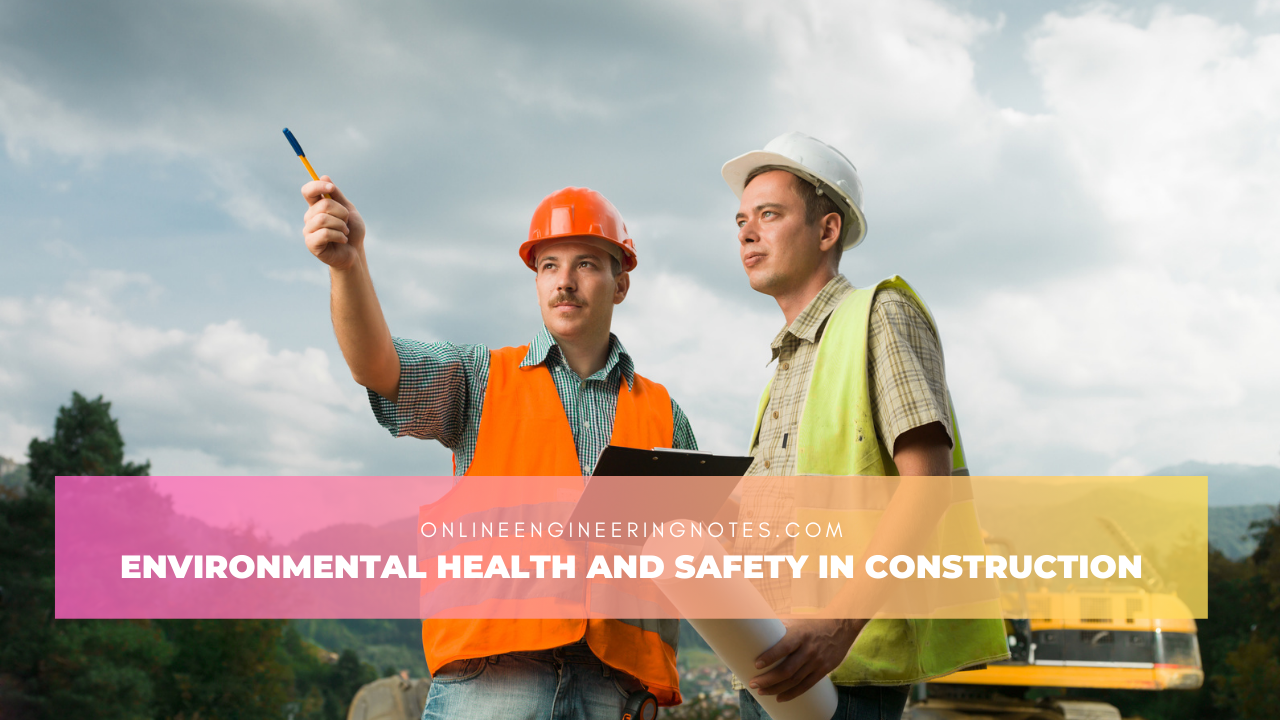1.1 Environmental Health and Safety (EHS)
- EHS stands for Environmental, Health, Safety which aims to prevent accident, minimize health hazard and protect surrounding from construction impact.
Causes of accident in construction projects:
1. Physical cause
- Malfunctioning or poorly maintained equipment.
- Uneven terrain or unstable structure.
- Absence of proper safety equipment.
- Lack of lighting.
- Improper lifting and moving of material.
2. Physiological cause
- Poor eyesight
- Poor health
- Over work
- Old age
3. Psychological cause
- Mental tension and stress.
- Lack of training.
- Overconfidence.
- Fear.
Minimizing the construction accident:
- Provide safety training.
- Equipment maintenance.
- Safety gear.
- Emergency plans.
- Health checkups.
- Keep workspace clean.
- Appropriate supervision.
1.2 Safety Planning
- Involves planning strategies and measure to ensure the well-being of workers and minimize risks at a construction site.
Steps in safety planning:
- Risk Assessment: Identify potential hazard.
- Safety policies: Develop clear safety guideline and protocols.
- Training: Provide safety training.
- Supervision: Assign responsible personnel to oversee safety measure.
- Regular inspection: Conduct routine checks to identify and rectify risks.
Personal Protective Equipment (PPE):
- Gear that worker wear to stay safe from risk related jobs to protect from physical harm.
Training to improve safety standard at construction site:
- Induction: New workers learn site rules and safety basics.
- Tool box talk: Short meeting discuss daily, safety tips.
- Skill training: Workers learn to use equipment safety.
Role of safety engineer:
- Risk assessment: Identify potential hazard on site.
- Safety plans: Developing and implementing safety procedures.
- Training: Educating workers about safety protocols.
- Accident investigation: Analyzing incidents for prevention.
- Inspection: Regularly checking for safety compliance.
1.3 Maintenance
- Maintenance involves regular checks, repair and prevent deterioration.
Importance:
- Prevent accidents.
- Extends lifespan of asset.
- Cost saves.
- Increase efficiency.
- Value preservation.
Objective of maintenance management:
- Minimize expenses.
- Ensure safety.
- Extend machinery lifespan.
- Increase Performance of equipment
- Effective resource utilization.
Types of Maintenance:
1. Planned Maintenance:
- Preventive Maintenance: Schedule check to prevent failure.
- Corrective Maintenance: Repairing after failure occurs.
- Routine Maintenance: Regular, simple upkeep tasks.
2. Unplanned Maintenance:
- Emergency: Urgent repair to prevent hazard.
Maintenance Planning:
- Scheduling
- Resource allocation
- Task prioritization
- Documentation
- Budgeting
- Historical analysis.
- Coordination
Issue of project maintenance in Nepal:
- Limited resource
- Lack of awareness
- Political instability
- Insufficient funds
- Technology gap
- Difficult location
- Lack of sustainable project
1.4 Organization and Management
Definition:
Organization: A group of people which works under an executive leadership.
Management: Art of using available resource optimally to achieve the desired goals.
Principles of Management:
- Division of work: Breaking tasks into smaller, specialized parts for efficiency.
- Authority and Responsibility: Assigning tasks and holding individual accountable.
- Discipline: Following rules and guideline for orderly work.
- Unity of command: Each worker report to only one supervisor.
- Unity of direction: Aligning efforts towards common objective.
- Order: Organizing resource and task for smooth operation.
- Equity: Treating all employees fairly.
Types of organization:
1. Line organization
- Clear hierarchy with direct reporting.
- Simple, quick decision making.
- Limited specialization.
2. Line and staff organization
- Dual authority structure.
- Access to expert advice.
- Potential conflict between staff.
3. Functional organization
- Grouping by specialized functions.
- Efficient use of specialized skill.
- Communication barrier between function.
4. Project organization
- Temporary teams for specific projects.
- Flexibility and innovation for project.
- Complexity in managing multiple project.
Leadership & Motivation:
Leadership
- Directing and inspiring a team towards goals.
- Guides teamwork, boosts morale and achieve success.
Motivation
- Encouraging interest and effort in tasks.
- Enhances performance, job satisfaction and result.
Project communication:
- Sharing information among team member for effective coordination and progress.
- Keeps team member informed.
- Involves all parties for project success.
Meaning and importance of HRM (Human Resource Management):
- Managing people within an organization for optimal performance.
- Hiring the right people for right roles.
- Enhancing skill and career growth.
- Creating a positive and motivated environment.
Recruitment, selection & training:
Recruitment: Attracting potential employees to apply for job position.
Selection: Choosing the most suitable candidates for the roles.
Training: Developing employee’s abilities.
Trade union in Nepal:
- Represent employees interest and right.
- Ensure compliance with labor laws and regulations.
- Addresses worker issues.
Reference:
• Harold Kerzner (2017). Project Management: A Systems Approach to Planning, Scheduling, and Controlling.
• PMI (2021). A Guide to the Project Management Body of Knowledge (PMBOK® Guide) – 7th Edition.
• Nebosh, Nepal Engineering Council Syllabus (2024). Engineering Professional Practice Notes.
• Civil Engineering Standard Method of Measurement (CESMM).
• Personal Class Notes & Presentations from Nepalese Engineering Institutions.

